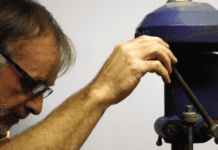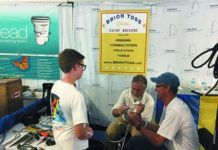We bought Viva, our 1975 Tartan 44 test boat, in December 1993. A lot of repair and upgrading has been done to her. One of the jobs, required on so many older boats, is redoing the electrical system. More often than not, the distribution panel doesn’t have enough circuit breakers, wire ends corrode, insulation gets scraped, etc.
During the second year of ownership, we tackled the AC and DC electrical systems. At that time, executive editor Dale Nouse’s son, Todd, had come home to roost and was between jobs. A handy guy, we set him to work pulling and replacing wiring, installing an inverter, Link 2000R battery monitor, stereo speakers and so on.
The fore and aft wiring is run under the hull-deck joint and is accessed in each cabin by removing several teak battens and a molded fiberglass-fabric panel. Lots of screws hold these pieces in place. About half of the original brass screws were so soft or corroded that they had to be drilled and removed with a screw extractor. A job that seemed like it should have taken 10 minutes suddenly took up an entire morning. Tedious and unrewarding. But out they must come.
Todd spent the better part of a spring and summer working on Viva and when he finally left town most of the electrical work had been completed.
Last fall, working on the short list of remaining projects, I bought four Caframo cabin fans. Their packaging claims they draw just .44 amps. My plan is to install two in the main cabin and two in the forward cabin. If I like them, I’ll probably mount another over each quarter berth. If we ever get to the tropics again, good cabin fans are essential to a comfortable night’s sleep.
Determined to get a jump on my spring list, over the winter I plugged away at some of the easier jobs, beginning with the fans. First, I removed all of the teak battens and fiberglass moldings to expose the wiring. Happily, I noted that all of the brass screws had been replaced with stainless steel screws and that the teak battens had been sanded and revarnished.
Good ‘ol Todd.
Removing the moldings was like opening a cave that had been inhabited years ago. In the wiring runs, I saw the twisted pairs of stereo wires Todd had routed to the new Bose speakers, evidence of his presence.
Next I unrolled a few feet of #12 2-conductor Ancor wire and began threading it from the distribution panel, up under the starboard deck, and forward, passing behind the nav station bulkhead. My plan was to screw a small terminal strip to the main bulkhead, behind the teak covering board that hides the chainplates, run one pair of wires through a hole in the covering board for the main cabin fans, then run another set from the terminal strip into the forward cabin.
Funny thing. There was already a terminal strip screwed in place, just where I wanted it. And there was a 2-conductor wire fastened to it with ring terminals. What was this? I traced the wire back to the distribution panel and found the end coiled up. There was a tag tied to the end with the note: “Dan, here are your fan wires.”
While installing the stereo speaker wires, Todd had had the foresight to run the fan wires, too. I guess he’d seen the empty circuit marked “Fans” on the panel and thought that as long as he’d had all the moldings removed, he might as well run the fan wires at the same time as the stereo wires. When I looked on the port side of the boat, he’d done the same there. Saved me a lot of time.
It’s not every day you run into a smart thinker like Todd. And when you do, you wish you could keep him around.
-Dan Spurr



































